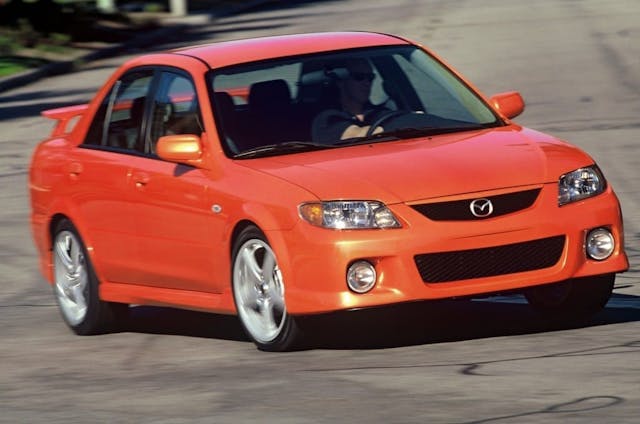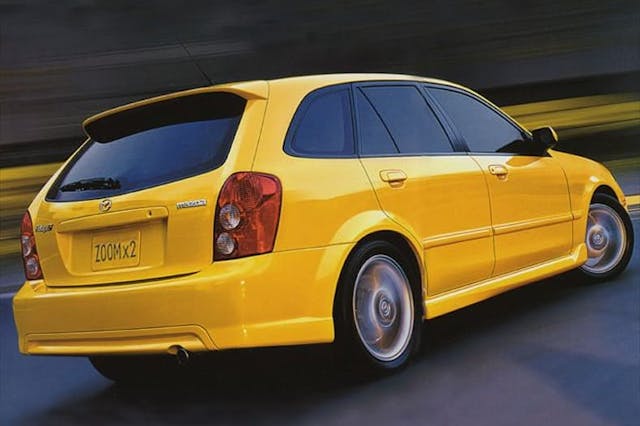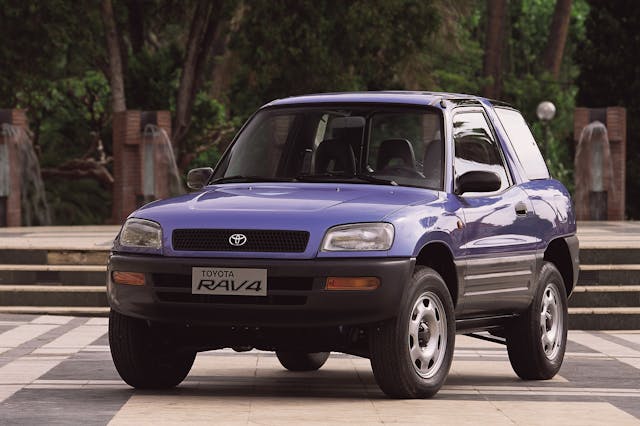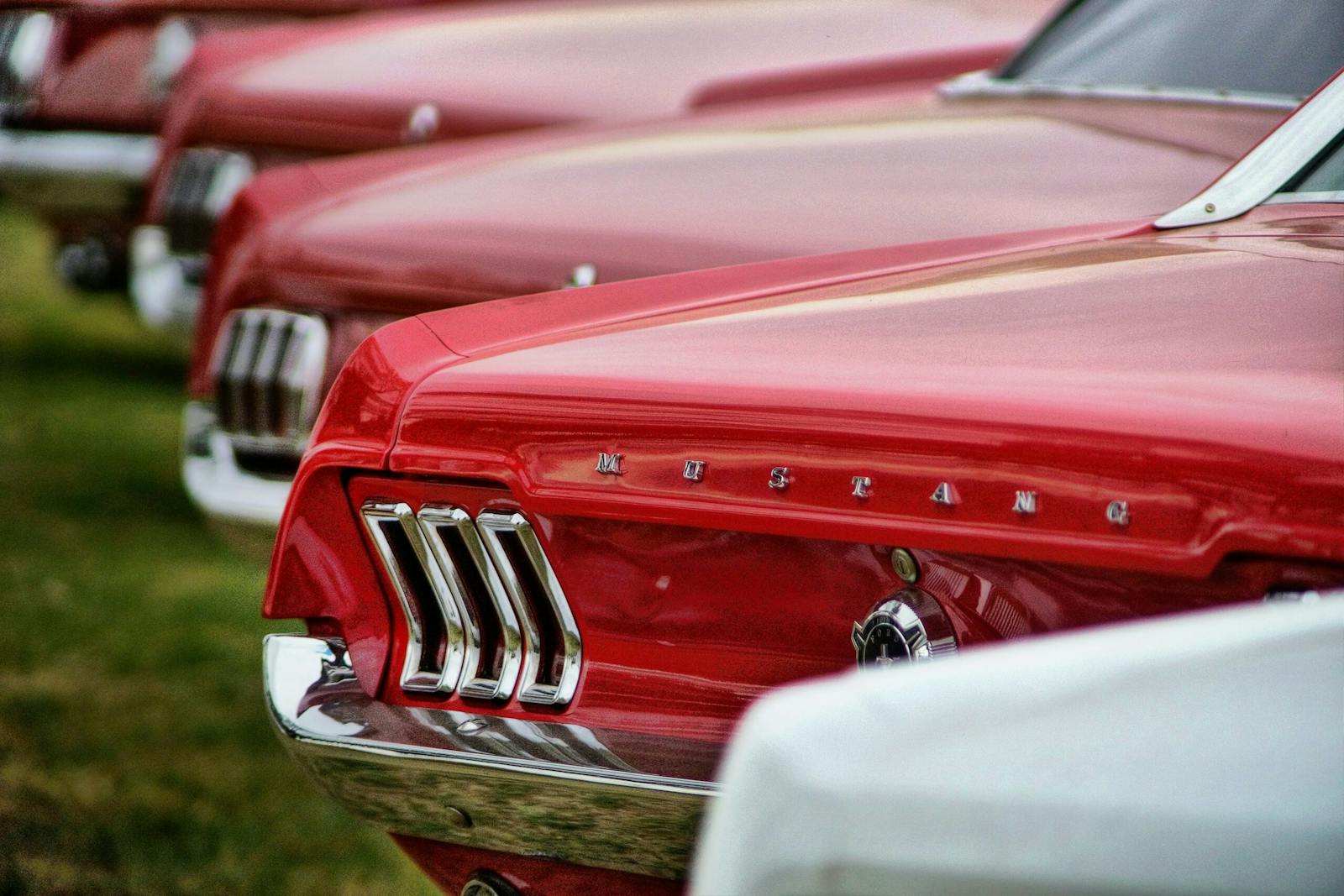5 Japanese cars almost nobody cares about (but should)
Even if you’ve been living in semi-quarantine for the last two years, there’s no missing the fact that nearly every flavor of interesting Japanese car has soared in value, many out of reach of most of us.
But there is still hope. If you make a habit out of trolling the margins of the collector car space on Facebook Marketplace and what’s left of the auto listings on Craigslist, you can find what remains of the affordable underbelly of interesting Japanese cars that nobody seems to care about. Yet.
Although most of five vehicles we’ve identified below aren’t in the Hagerty Price Guide, we can track how many people are calling us about them for a quote on insurance. No surprise, the numbers are going up.
2003–04 Mazdaspeed Protégé

Mazda is probably the closest thing to a cult brand left after the demise of the last true cult brand—Saab. Quirkiness and Performance has always been in the Japanese outfit's DNA. It’s no surprise that this story is dominated by cars from the brand formerly tag-lined with “zoom zoom.” Stung by its inability to get the complete package right with the somewhat anemic Protégé MP3, Mazda produced this, the Mazdaspeed Protégé, which upped the ante to 170 hp via a Callaway-engineered Garrett T25 turbo. Limited-slip diff, big brakes, and meaty for the day 17-inch wheels and tires added up to GTI chaser with Japanese reliability. No surprise, they’re rare in any condition, and most seem to be properly roached, but nice ones can still be found under $10,000. A perfect one with 24,000 miles has been for sale for quite some time at $16,000. That said, the average value cited by those calling Hagerty for insurance policies on a Mazdaspeed Protégé has more than doubled in the last two years, from less than $5000 to nearly $12,000.
2000–05 Toyota MR2 Spyder

There’s a reason why automakers don’t listen to enthusiasts—the mouthy ones who clamor for a lightweight, modestly powered, mid-engine sports car, and then don’t buy it when its available. The MR2 Spyder was a modern-day Porsche 914, an early Lotus Elise that didn’t hurt to get in and out of. It was comfortable, stiff for an open car, a superb handler, and decently quick for a car with under 140 hp (0-60 in 6.9 seconds). In its own way, it was probably even as quirky as the first-gen Mister Two, with its goofy bug-eyed visage.
And yet practically nobody remembers it. About $9000 buys one in driving condition (a "#3" in Hagerty Price Guide parlance). JDM hipsters will pay more money for a right hand-drive Honda Beat or Suzuki Cappuccino. Will that last? Our colleagues in the U.K., at least, highly doubt it—they included the MR2 on their 2021 Bull Market list.
2002–03 Mazda Protégé 5

Long-roofs are undergoing a renaissance. Not in the new car world, of course—they’re all but extinct there—but among younger enthusiasts who don’t have a recollection of a time when wagons had fake wood sides, and back back seats. Euro wagons like E46 BMWs and Audi A4s are getting scarce, mainly owing to the fact that the annual maintenance costs of Euro wagons with 180,000-plus miles are petrifying. Not so for Japanese cars, and the Protégé 5 exists in a size category that the Europeans almost never catered to in a wagon, unless you feel like searching out an Opel Kadett wagon or somesuch silliness. No matter, the 5 was so much better. With the serviceable underpinnings of the nippy Protégé, you also got a hatch, decent cargo space, and all of the aftermarket upgrades available for the less inspiring sedan. Did we also mention that bright yellow and a five-speed manual were common? Salt-belt cars are all becoming terminally rusty at this point, but a nice Cali 5 with 175,000 or so miles on it still has plenty of life left in it for somewhere around $4,500—roughly the average value people cite when they call Hagerty for insurance on one. That makes it the least expensive car on our list.
1994–2000 Toyota RAV4

Hear us out on this one. A new RAV4 is the essence of car ambivalent sense and sensibility. But the first-gen (XA10) RAV was something different altogether. Bare bones in a way that few if any vehicles are today, they’re virtual perpetual motion machines—most that you’ll see have more than 250,000 miles on them. Perhaps the most appealing variant is the clean-looking three-door with a five-speed manual transmission. While maybe not as appealingly boxy or off-road capable as a Suzuki Samurai or a Mitsubishi Montero, a clean, early RAV4 with a five-speed at this point is rare, and seems too nice for winter beater status even at the usual six-grand-or-so asking price.
2003–2008 Mazda 6 Wagon

Did we mention we like wagons? And Mazdas? Think of the Mazda 6 as an alternative to a B5-generation Audi A4 wagon, only without most of the cluster headaches that come with vintage Audi ownership, or sadly, the AWD option. What makes the 6 so appealing beyond the quite clean and competent styling is the fact that it was available with a 3.0-liter Ford-sourced Duratec 30 V-6 paired with a manual transmission option. While not exactly common, manual 6 wagons aren’t impossible to find, either. Sadly there was never a Mazdaspeed 6 wagon option in the United States, but we’ve heard of people doing a drivetrain swap to make the wagon that Mazda should have built. Or if you can forego the handiness of a wagon, just snag a Mazdaspeed 6 sedan. Hagerty's insurance data do not differentiate between wagon and sedan, but 6 values have overall been stable around $9000.
Rob Sass is the Editor-in-Chief of Porsche Panorama, the official publication of the Porsche Club of America. The opinions stated are his, and not necessarily those of the Club.


